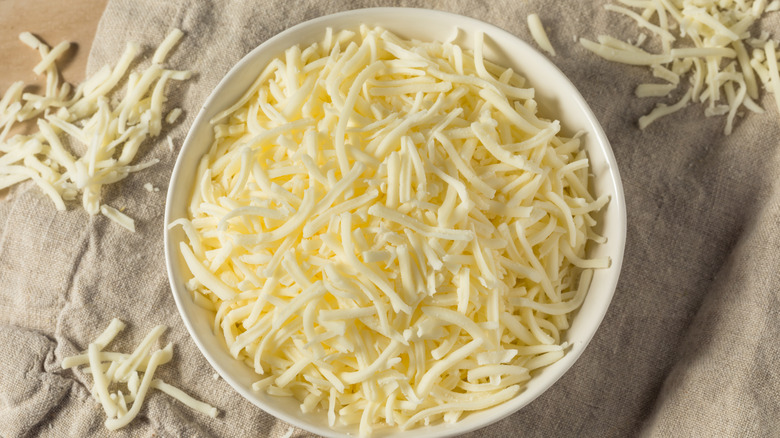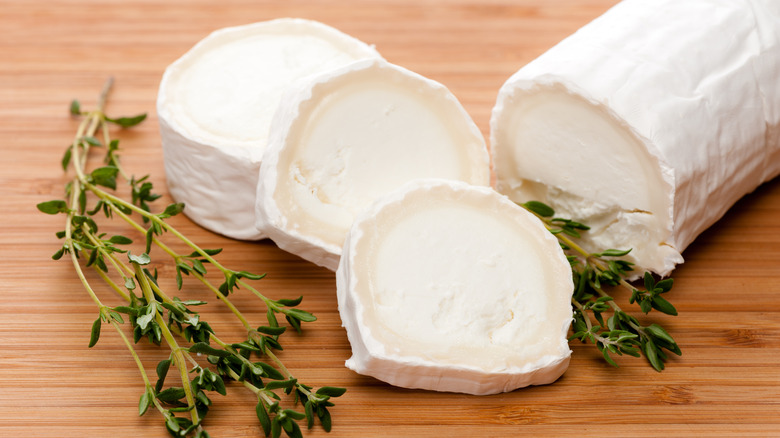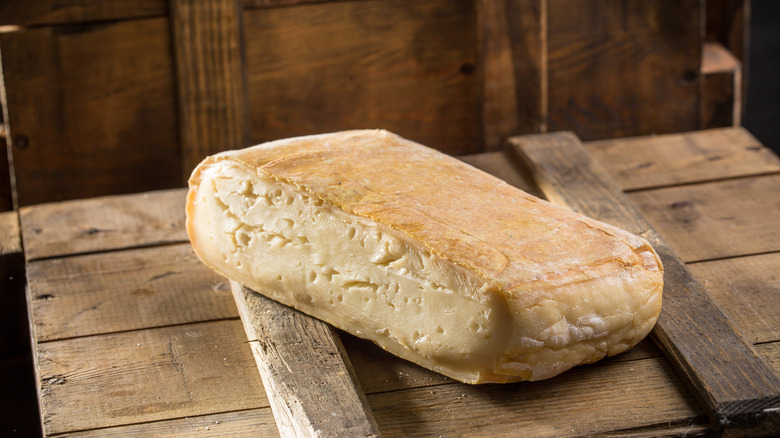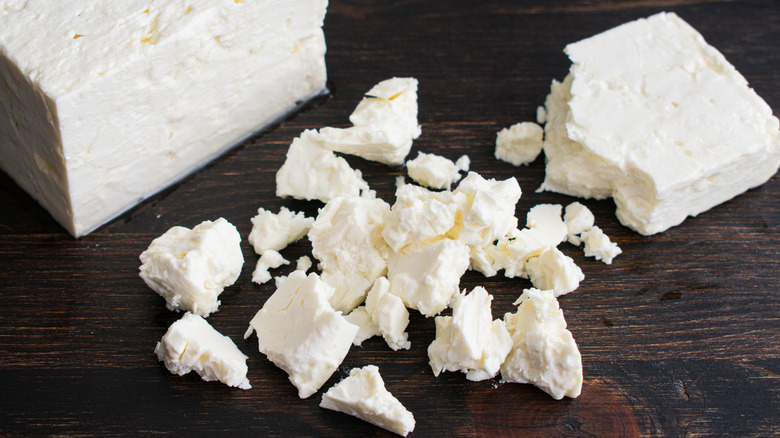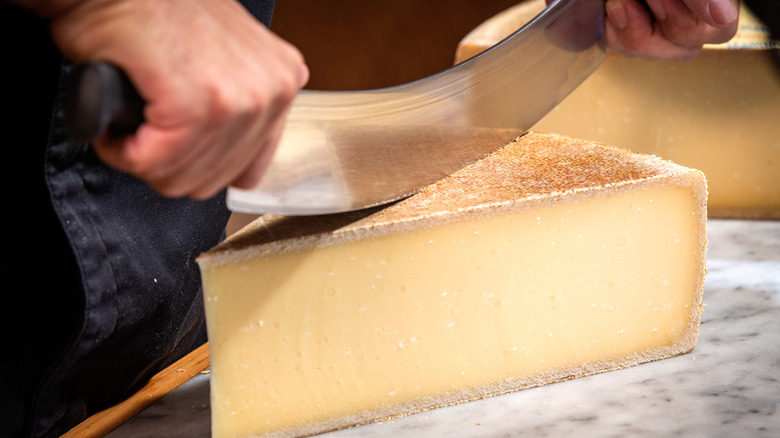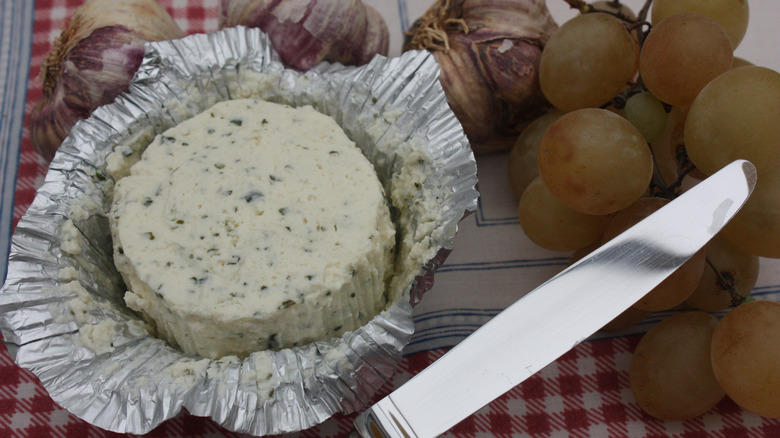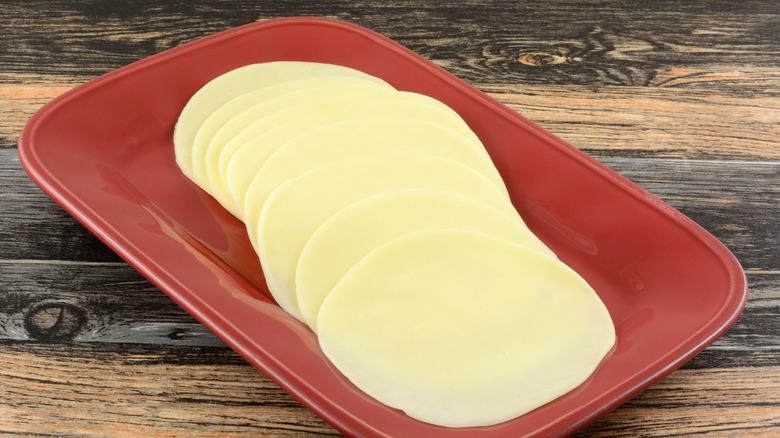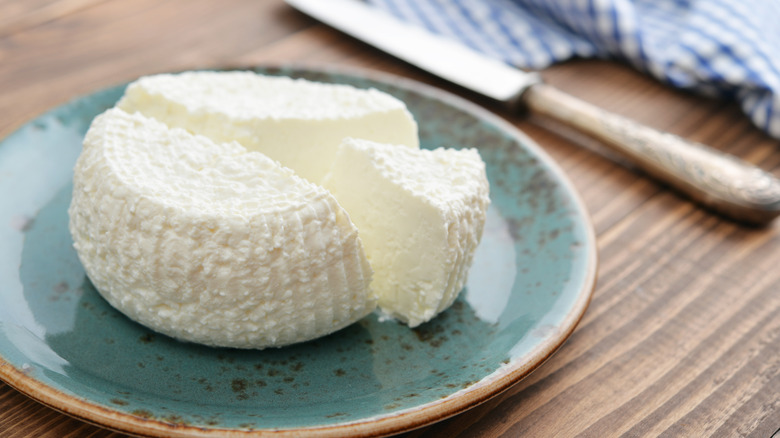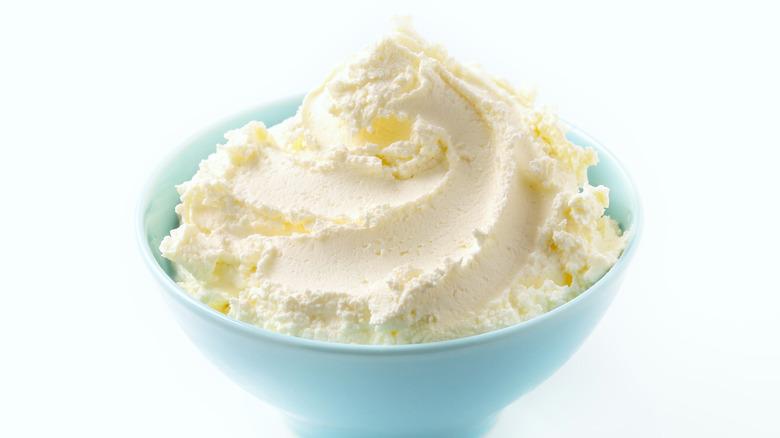The Absolute Best Types Of Cheese For An Omelet
Although omelets may require a bit more time and finesse than a plate of scrambled eggs, they're totally worth it. This breakfast dish is super customizable and easy to tweak to fit your palate — and whatever ingredients you have in your refrigerator. You can go with a Denver omelet featuring the classic trio of onions, green pepper, and ham, or you can get creative and add oysters to your omelet for a straight-from-the-sea flavor. Though as delicious as these additions sound, the best omelet filling is undoubtedly cheese.
There is seemingly no limit to what type of cheese you can add to your omelet, but there are certain kinds that work better than others in this egg dish. We curated a list of some of the best types of cheese for your omelet based on several important factors. While many of them will yield the melty cheese pull perfect for twirling around your fork, others make a great fit for an omelet in their own way — either by complementing other common filling additions or providing a novel texture that will keep your eggs both moist and interesting.
Cheddar
Cheddar is a familiar type of cheese, both among cheese enthusiasts and general consumers. This cow's milk cheese is widely available in most major grocery stores in both the signature cheese section as well as the general refrigerated aisle. Its flavor is generally mild compared to some of the funkier types of cheeses on the shelf, and it melts very, very well.
The aging process impacts the flavor of cheddar tremendously, so you'll want to take a peek at the label before you use your pre-grated cheddar or grate your own at home. Mild cheddars may only have a few months of aging compared to extra-sharp cheddar, which can be aged for upwards of two years. Younger cheddars tend to have more buttery and mild notes, so they're an excellent choice if you're adding lightly flavored additions to your omelet, like chives. Sharp cheddar can hold up better to more robust flavors, which makes it a solid pairing for ham, bacon, and even crumbled chorizo.
All in all, cheddar's agreeability makes it one of the better cheeses to use for an omelet. It's also a great choice for feeding to kids who may not have the same refined cheese taste or appreciation for stinky blue cheese as older eaters.
Mozzarella
When you think of mozzarella, your mind probably goes immediately to pizza — which is totally fair. It is an excellent cheese to slather on stretched dough with tomato sauce and pepperoni. And although it hasn't really made its way onto the omelet scene just yet, mozzarella is a contender for one of the top omelet cheese spots.
The reasoning for this is how easily mozzarella melts. Processed mozzarella is a better choice over fresh when you're making something like an omelet because it has a more profound flavor and melts more readily than the balls or logs of mozzarella you'd find at the cheese counter. Every bite of an omelet made with mozzarella is gooey, and it will easily coat your other fillings. Moreover, this processed mozzarella, otherwise called low-moisture mozzarella, won't get gunky and watery as it melts, which means that you won't have to contend with an odd mouthfeel and pockets of liquid in your finished omelet.
Mozzarella is generally agreeable and really only has a milky flavor with some hints of salt. But it works well in omelets with fillings that you'd see on a pizza, like sun-dried tomatoes, peppers, and ham.
American
The best type of cheese to melt seamlessly into your omelet is undoubtedly American. This is one of the cheapest and most widely available cheeses that you can buy at the grocery store. It's most often sold in those iconic plastic sleeves; all you need to do is crack one open and tear it into pieces over your omelet. American cheese melts comparatively well because it's made with fillers like milk protein concentrate, skim milk, and milk fat, which together encourage quick, easy melting.
American cheese is a great cheese to work with if you consider yourself an omelet novice. Since the cheese melts so fast, you can add it to your omelet towards the end of the cooking time. If you were working with a heartier cheese, you'd have to balance the melting time of the cheese with the cooking time of the eggs. And there's nothing worse than a dry, overcooked omelet — even if you get melty cheese.
American's flavors are typically akin to that of a very, very young cheddar. It's great to enjoy solo, but you can also crumble up some bacon or ham to make it a little more filling.
Goat cheese
Goat cheese, or chèvre, is more approachable cheese than you might think. As the name suggests, it's made with goat's milk rather than cow's milk, which contributes to its moderately tangy and unique flavor. Although you can find plain goat cheese at the store, you can also find an array of goat cheese logs rolled in herbs or packed with fruit.
Young goat cheese is much softer and easier to spread than aged varieties, which tend to take on a more crumbly texture. If you're whipping up an omelet, you'll want to select fresh goat cheese rather than the drier, crumbled version. Although the melt on the fresh version won't be as seamless as that of shredded cheddar or mozzarella, you don't have to worry about a rubbery mouthfeel, as you would with crumbled aged chèvre.
Fresh goat cheese works best with flavors that allow its earthiness to shine. Think chives, shallots, and a sprinkle of herbs de Provence.
Taleggio
The aroma of this Italian cheese may turn you off at first whiff, but we promise that it's worth trying a bite (or two). Taleggio melts very well and has a toothsome texture that complements the mildness of its flavor. If anything, the flavor of this cheese is unexpectedly fruity — and one that you will taste even after you've finished eating it. Although the rind is entirely edible, it's covered in up to five different kinds of mold that help preserve the cheese and give it its distinctive aroma. To help make this cheese a little more approachable, we recommend removing the rind and just using the soft inside of this cheese.
Taleggio is far from a popular omelet cheese, but it's still a solid option when you're craving something more unctuous than just a hunk of cheddar. The cheese's fruity notes pair well with spicy and aromatic garlic and onions. Taleggio works best in omelets where it's allowed to complement the other fillings rather than stand alone.
Fontina
Fontina cheese deserves more positive press than it gets. If you can get your hands on authentic Fontina cheese, it's totally worth it. This true Fontina has a Protected Designation of Origin (PDO), so you should expect to pay a premium for the real deal.
This Italian cheese is made with cow's milk and has upwards of 45% fat. More fat often means a better melt, so you can expect Fontina to easily transform from its solid state into an ooey, gooey filling inside your omelet. Because this cheese is historically made with unpasteurized milk, it takes on the flavor of whatever the cows who made the milk ate — similar to how grapes absorb the flavors of the soil and the surrounding growing environment and create a wine's terroir. Widely speaking, the flavor of this cheese is very earthy and grassy, which makes it a good pairing for vegetables. Pair it with fresh spinach, mushrooms, and thyme.
Feta
Feta cheese is briny and salty, and you're probably more familiar with it on a salad than inside an omelet. This is probably because feta is far from melting cheese. The heat softens the cheese just a little bit, but it never really loses its crumbly texture. So, don't think that feta is going to replace the luxurious feeling of biting into a soft, cheddar omelet loaded with bacon bits.
Rather, you should consider adding feta to your omelet for its flavor. If you use a feta that has been brined and aged for upwards of a year, you can expect it to have a stronger peppery flavor that has a profile similar to fresh arugula. If you're shopping for a block in the store, you should also aim for a cheese that's made with sheep's milk rather than cow's milk. You'll get some tart and tangy notes in the cheese with lemon undercurrents in the sheep's milk cheese, which are a great complement to the richness of the eggs. Cow's milk feta is really just made in a feta style and lacks the same flavor nuances.
Gouda
The spotlight for omelet cheeses is often on American or cheddar, but we think that gouda also deserves some recognition. Although both gouda and cheddar are cow's milk cheeses, the former tends to take on a more moderate flavor profile. It also has more fat than cheddar cheese, which means it melts really well. It's why gouda often makes an appearance in recipes for grilled cheese, mac and cheese, and more.
Since gouda has a very buttery flavor, it's easy to pair with other, more robust cheeses in an omelet like cheddar. Herbs like dill and rosemary can help highlight the gouda's nutty and mild undertones, while bacon can help make the omelet a bit more robust. You can also add your favorite veggies to a gouda omelet, including flavorful, acidic ones like onions, tomatoes, and more.
Pimento cheese
Pimento cheese is a "cheese" (if you can even call it that) that combines some of the best omelet elements into a creamy, easily spreadable schmear. The exact recipe for this cheese will depend on who's making it, but there are a few important staples: Grated cheddar cheese, pimento peppers, cream cheese, and mayonnaise. The cheeses are pretty standard for omelets, and so are peppers — but why would you want to extend an omelet invite to mayonnaise? Besides giving the cheese a spreadable consistency, mayo makes the eggs super flavorful because it's made with eggs, oil, and an acidic element. The mayonnaise from the pimento cheese will enrich your omelet and improve its flavor, making it a worthy addition on its own. The other "stuff" in the pimento cheese is just a bonus.
After you tuck the pimento cheese neatly into your omelet, you won't need to add much extra as far as fillings go — unless you have a few spare pieces of bacon lying around. Scoop a spoonful of the pimento cheese into your omelet before tucking the side over, and let the cheddar melt for a couple of minutes before serving.
Gruyére
Gruyére is an Alpine cheese that's no stranger to breakfast food. After all, it's the staple cheese of the delicious croque madame sandwich. This cheese is a great pairing for eggs because it has a uniquely hazelnutty and warming quality to it. Not to mention, it's a great melting cheese because of its high fat content.
We recommend pairing this cheese with elements similar to those found in a croque madame, including ham and Dijon mustard. The cheese can easily stand its ground against the salty and spicy flavors from these additions. However, the butteriness of the cheese also makes it an excellent accompaniment to common omelet additions like asparagus, spinach, and bacon — which allow its nutty and sweet undertones to come through. Although the name of this cheese and its accent mark may make you think it's a very designer and pricey cheese, it's quite affordable and available at major grocery stores for all your omelet needs.
Emmentaler
Emmentaler is the cheese that you think of when you hear "Swiss" cheese. It has holes (called eyes) and a hard rind on the outside that protects the fruity, acidic cheese inside. It's a quintessentially grassy cheese and has a slightly acidic pop because of the bacterial cultures it's treated with. Your otherwise rich omelet could go for this acidic reprieve, which makes Emmanteler an excellent option for a wide range of omelet fillings.
Emmanteler is a great cheese for a classic French omelet because it allows the simple flavors of the butter and eggs to shine through. You can also complement it with a woody flavor, like asparagus or mushrooms, to help mellow out the saltiness and the acidic quality of the cheese.
Boursin
Wait, isn't Boursin more of a schmear than a cheese? Although it is commonly recognized by its brand name, this spread is actually made from Gournay cheese, a cow's milk cheese that bears a striking resemblance to the color and texture of chèvre. However, the flavor of Gournay is much milder.
The texture of this unique cheese product is a little bit firmer than cream cheese, but it's otherwise super buttery and takes on the profile of whatever seasonings it's mixed with. In the case of Boursin, you'll get a magical blend of garlic, white pepper, chives, and parsley. It's a perfect cheese to use for your omelet when you don't want to undergo the laborious task of cutting and adding these herbs to your omelet separately. Crumble the cheese on top of your omelet before the final fold to get the delicious flavor of this spread with every bite.
Cottage cheese
We're admittedly not the biggest fans of cottage cheese, but we can agree that it unlocks the creamiest scrambled eggs to ever exist. A smooth cottage cheese can help keep your eggs super moist. So, it's reasonable to see how adding this cheese to your omelet might have the same effect. It's a great addition to your breakfast if you're looking for something high-protein, and it makes a filling complement to spinach, peppers, and onions.
The key to working with cottage cheese is to know that it tends to leach water when it's cooked. But you can counteract this by pairing it with melty, low-moisture cheese, like cheddar or mozzarella, or just adding a bit of cottage cheese to your omelet after you've pulled it off the heat.
Roquefort
Roquefort isn't for everyone, and it has nowhere near the same mildness and agreeability as cheddar or American. This sheep's milk blue cheese is a step above Stilton or Gorgonzola, so you should only use it if you like the flavor of moldy cheese. Its flavor is very, very strong, so you need to pair it with omelet fillings that can hold their own — like bacon and sun-dried tomatoes.
Roquefort is one of our favorite types of cheese to use in an omelet because it overwhelms your tastebuds with waves of different complexities. If you can get past the initial tangy and savoriness loaded with strong pepper notes, you'll be greeted by notes of caramel and honey. It's worth sticking around for because this is one of the most flavorful cheeses you can use in an omelet.
Provolone
Provolone might not be an omelet cheese that's even on your radar. This Italian cheese is widely available at deli counters and in the pre-sliced cheese section of your local grocery store. Its smooth, creamy texture melts beautifully when heated, creating a luxurious mouthfeel that blends seamlessly with the eggs in your omelet. Unlike some cheeses, provolone doesn't overpower the other ingredients; instead, it enhances them with its mild, slightly salty taste.
Provolone works well with other ingredients, including different types of cheese. It doesn't deliver any sharpness by itself, so pairing it with a cheddar would make it a more robust option for your breakfast. You could also accentuate the meltiness by adding Emmentaler, which will clue into the buttery notes of the provolone.
Ricotta
Adding cheese to your omelet can set you up for a very dense and heavy breakfast. But that doesn't have to be the case when ricotta is involved. Its light, soft mouthfeel sets it apart from other cheeses. Moreover, this cheese has a subtle sweetness that will put your other fillings at the forefront, but still allow for additions like peppery arugula, tomatoes, and onions to take the stage.
The key to adding ricotta to your omelet is to first infuse it with herbs, salt, and flavor before adding it to your recipe. Start by mixing your ricotta with salty and umami-forward ingredients like Parmesan and dried herbs to help tone down the sweetness. Like other soft cheeses, melting isn't ricotta's forte, so you'll want to plop a little on the omelet during the last fold and serve it while it's still hot.
Cream cheese
If you're after a tang in your omelet, grab a block of cream cheese from your fridge. This soft, fresh cheese is very dense, but it can add a unique, toothsome mouthfeel to your omelet. As any bagel enthusiast would know, cream cheese doesn't really alter the profile of whatever it's on; it instead serves as an agent for carrying flavor.
You don't have to use just plain cream cheese, either. Grab a scallion and chive variety to infuse these omelet-compatible flavors into your breakfast. Or take savory things a step further and grab a lox-infused cream cheese to add a fishy undertone to your omelet.
It's important to note that cream cheese loosens when it's set on something warm (like a toasted bagel), but it never fully melts. So, you should expect a slightly doughy mouthfeel when you bite into a cream cheese-filled omelet.


